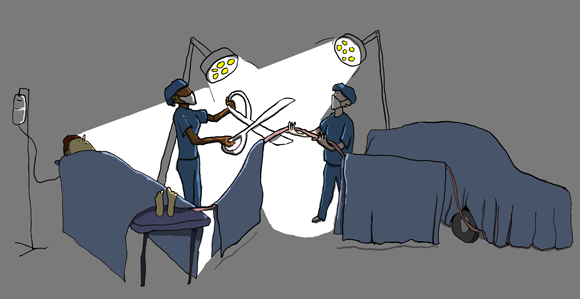Medical & Surgical Management
A medical or surgical approach to carbon detoxification presents a dilemma in the light of recent evidence on the carbon impact of drugs and equipment.
A carbon footprint of the NHS in England, published in 2008, has revealed that despite routine overheating of hospitals and health centres, and the accepted practice of keeping all lights and equipment “to the ready”, direct energy use accounts for only 22% of NHS carbon emissions. [1]
Another 22% (or 4 million tonnes of CO2) comes from the production and supply of pharmaceuticals, with a similar proportion from purchase of medical equipment and dressings, etc.
Medical Interventions
From the above, it is evident that where a patient is unsuccessful in reducing other high-carbon behaviours, medications will actually lead to an overall increase in carbon consumption. (A similar problem can occur with use of nicotine replacement in treatment of cigarette addiction.)
A useful intervention here is the Medication List Review. This is an innovative technique, whereby all Medications currently being used by the patient are noted down in a List, and their therapeutic value Reviewed before deciding whether to continue them.
A related intervention is the Clinic List Review. Here, the list of patients expected in clinic is reviewed and opportunities sought to save them a (carbon-fuelled) journey. Options include running one-stop clinics, or offering telephone consultations.
Surgical Interventions
Surgical treatment for carbon dependence remains very much unproven. However, the more adventurous of surgeons may wish to consider the following pioneering techniques.
Of note, all carbon detox. surgery is best performed without anaesthetic, in view of the extreme potency of inhaled agents as greenhouse gases (200-1500x relative to CO2) [2], and the large amount of un-recycled waste generated by anaesthetists [3]. If absolutely essential, a local or regional nerve block is the recommended option.
Division of patient-car connecting structures
NB: though invisible, these are often tough and elastic, and may re-grow.

Stomach stapling
The most well-established surgical option: effective in reducing dietary carbon excesses.
Targeted ablations of the “internet shopping centre” in the brain
Warning: in entrenched cases this centre may be found in brainstem - in which case ablation is inadvisable. Even in suitably-selected patients, online carbon footprinting is often impaired following surgery, and substitution by car-assisted shopping trips may even lead to a net increase in carbon use.
Implantation of smart meter / energy monitor
Connects remotely to sensors on power cables at home or in the workplace, to give the patient real-time data on their energy use. (Critics have pointed out that a portable device may be sufficient, and avoids the risks of hospital-acquired infection etc).
Organ sharing
Inspired by the efficiencies of the “multifunctional device” (combined printer-copier-scanner-fax etc), it has been proposed to surgically attach one patient to another, in order to reduce the total number of organs necessary for survival. (Indeed, the resource efficiencies of conjoined twins are now apparent as roughly proportional to number of organs shared.) Proponents point out that any redundant body parts can be recycled, or converted to biogas through anaerobic digestion.
Electrical Interventions
Solar-powered Electro-Convulsive Therapy (ECT) may possibly be of therapeutic value but remains available only in a research setting at present. It is hoped that collaboration with renewable energy providers will allow NHS provision of solar ECT within the next 3 years.

